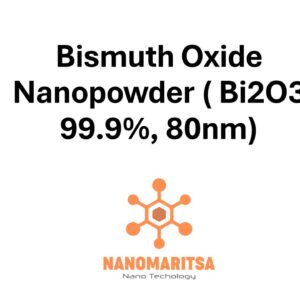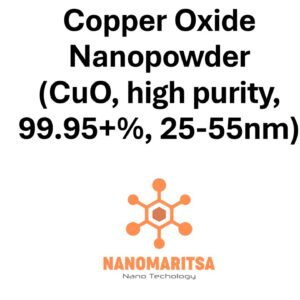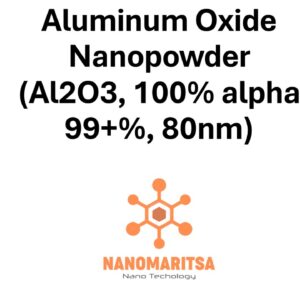Indium Hydroxide Nanopowder (In(OH)3, 99.99%, high purity, 20-70nm)
€220.00
CompareIndium hydroxide nanopowder (In(OH)₃, 99.99%, high purity, 20–70 nm) is a specialized material with unique properties that make it valuable in various fields, such as electronics, catalysis, and environmental remediation. Due to its high purity and nanoscale size, it offers enhanced reactivity and performance in applications that require precise control of material properties.
Composition and Structure
In(OH)₃ (Indium Hydroxide):
Indium hydroxide is a compound composed of indium, oxygen, and hydrogen. It forms as a white precipitate and is typically insoluble in water. It exists as a weak base and can act as a precursor to indium oxide, a valuable material in electronics and optics. Indium hydroxide nanopowder can be used to produce thin films, composites, or other advanced materials.
Purity (99.99%):
The nanopowder’s extremely high purity ensures minimal contamination, which is critical in applications requiring consistent and precise material properties, such as in semiconductor devices or optical coatings.
Particle Size (20–70 nm):
The nanopowder’s particle size in the range of 20 to 70 nm offers high surface area and increased reactivity, making it ideal for catalytic and sensor applications. It also enhances the material’s properties for use in energy storage systems and thin films.
Properties
- High Surface Area:
Due to the nanopowder form, In(OH)₃ has a large surface area, which enhances its reactivity and makes it highly suitable for use as a catalyst or adsorbent in chemical reactions. - Semiconducting and Precursor Properties:
Indium hydroxide can act as a precursor for the production of indium oxide (In₂O₃), a widely used semiconductor material. It also exhibits weak semiconducting behavior, which can be utilized in specific electronic applications. - Chemical Reactivity:
In(OH)₃ is chemically reactive, particularly under alkaline conditions, and can readily convert into indium oxide upon heating. This property is valuable in material synthesis and in producing other indium-based compounds. - Environmental Compatibility:
Indium hydroxide is relatively non-toxic and can be safely used in environmental applications, such as water treatment, without causing significant harm to ecosystems.
Applications
1. Electronics and Semiconductors:
Precursor for Indium Oxide Films:
Indium hydroxide is used as a precursor for the deposition of thin films of indium oxide, which are widely employed in transparent conductive coatings for touchscreens, solar cells, and flat-panel displays.
Semiconductor Applications:
In(OH)₃ is utilized in the production of semiconductor materials, particularly for applications requiring precise doping or the formation of oxide layers on semiconductor surfaces.
2. Catalysis:
Catalyst for Organic Reactions:
Indium hydroxide nanopowder is employed as a catalyst in certain organic reactions, especially in the synthesis of fine chemicals and pharmaceuticals. Its high surface area and reactivity enhance reaction efficiency.
Oxidation Reactions:
In(OH)₃ is used in oxidation processes, particularly in the production of chemicals where the conversion of carbon monoxide or hydrocarbons is necessary.
Catalytic Converters:
Indium hydroxide is also being explored as a catalyst in automotive catalytic converters, where it helps break down harmful emissions into less toxic substances.
3. Environmental Applications:
Water Purification:
Indium hydroxide nanoparticles can be used in water purification systems, particularly for removing heavy metals and toxic substances from contaminated water. The material’s large surface area and adsorptive properties make it effective in filtering and purifying water.
Pollutant Degradation:
In(OH)₃ can also be utilized in environmental remediation processes, where it acts as a catalyst for the breakdown of organic pollutants in air and water.
4. Energy Storage and Conversion:
Supercapacitors and Batteries:
Indium hydroxide is being explored for use in energy storage devices, such as supercapacitors and lithium-ion batteries. Its semiconducting properties and large surface area make it an attractive material for improving charge storage and energy efficiency.
Photocatalysis:
In(OH)₃ can be employed in photocatalytic applications, such as water splitting for hydrogen production or the breakdown of organic pollutants under UV light. Its ability to absorb light and facilitate chemical reactions makes it useful for renewable energy technologies.
5. Research and Development:
Nanomaterial Synthesis:
Indium hydroxide nanopowder is an important material for the synthesis of advanced nanomaterials, including indium oxide and indium-based composite materials. Its versatility makes it a key component in nanotechnology research.
Quantum Dots:
Research into quantum dots and nanostructures often involves the use of indium hydroxide as a starting material. It is used to create indium-containing quantum dots, which have applications in quantum computing, photonics, and medical imaging.
Safety and Handling
Health Considerations:
Indium hydroxide is considered to have low toxicity, but, like all nanoparticles, it should be handled with care. Proper safety measures, including gloves, masks, and eyewear, should be used to avoid inhalation or skin contact.
Environmental Impact:
Indium hydroxide is generally considered environmentally safe, though research into its long-term effects is ongoing. As with all chemical substances, it should be disposed of properly, following relevant environmental guidelines.
Summary
Indium hydroxide nanopowder (In(OH)₃, 99.99%, high purity, 20–70 nm) is a versatile material with a broad range of applications in electronics, catalysis, environmental technologies, and energy storage. Its high purity and nanoparticle size provide enhanced reactivity and surface area, making it ideal for use in producing indium oxide films, as a catalyst, and in environmental remediation. Indium hydroxide is also being explored in energy storage devices and photocatalytic applications, positioning it as a valuable material for the development of next-generation technologies.
| Measurement (gr) | 100 grams, 500 grams, 1000 grams |
|---|
Related products
-
Single-Element Oxides Nanopowder
Bismuth Oxide Nanopowder ( Bi2O3, 99.9%, 80nm)
0 out of 5(0)SKU: MN09NP0211€60.00 This product has multiple variants. The options may be chosen on the product page -
Single-Element Oxides Nanopowder
Copper Oxide Nanopowder (CuO, high purity, 99.95+%, 25-55nm)
0 out of 5(0)SKU: MN09NP0221€160.00 This product has multiple variants. The options may be chosen on the product page -
Single-Element Oxides Nanopowder
Aluminum Oxide Nanopowder (Al2O3, 100% alpha, 99+%, 80nm)
0 out of 5(0)SKU: MN09NP0201€40.00 This product has multiple variants. The options may be chosen on the product page -
Single-Element Oxides Nanopowder
Aluminum Hydroxide Nanopowder (Al(OH)3, 99.9%, 100nm)
0 out of 5(0)SKU: MN09NP0210€80.00 This product has multiple variants. The options may be chosen on the product page






